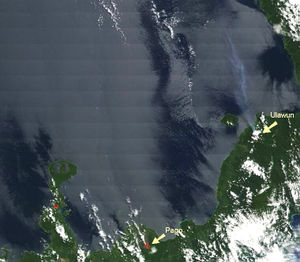Ulawun
2007 Schools Wikipedia Selection. Related subjects: Geography of Oceania (Australasia)
| Ulawun | |
|---|---|
 A steam plume from Ulawun is clearly visible on this satellite image |
|
| Elevation | 2,334 m (7,657 ft) |
| Location | West New Britain, Papua New Guinea |
| Coordinates | |
| Type | Stratovolcano |
| Last eruption | 2005 |
Ulawun is a volcano situated on the island of New Britain, Papua New Guinea, about 130 km southwest of Rabaul. It is the highest mountain in the Bismarck Archipelago, and one of the most active volcanoes in Papua New Guinea. Several thousand people live near the volcano.
Geological history
The volcano's first known eruption was in 1700, when English explorer William Dampier found it in eruption. Eruptions have been common in the last century, generating frequent ash columns, and occasional pyroclastic flows. Particularly large eruptions occurred in 1898, 1915, 1970, 1978,1980, and 1985.
One potential hazard at the volcano is cone collapse. This seems to have happened at least once in the past, creating a large cliff on the north side of the mountain. Eruptions from the flank and seismic activity may destabilise the top of the mountain, leading to catastrophic landslides.
In light of the dangers presented by the volcano to local populations, it has been designated a Decade Volcano and is subject to particular study by volcanologists.
Recent activity
The last few years have seen almost constant activity at Ulawun, with frequent small explosions.
Volcanoes in Papua New Guinea are some of the world's most prolific sources of sulphur dioxide. Recent studies have shown that Ulawun releases about 7 kg/s of SO2, which is about 2% of the global total of SO2 emissions into the atmosphere.